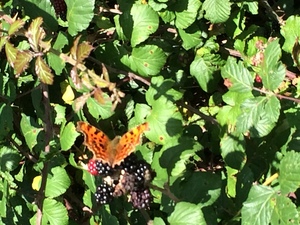
Our summer job of registering butterflies is drawing to a close. Each week one or more of us goes up the Mendips to count what butterflies are in the transacts or sections of the walk that we exactly tread . This year has been reasonable although alas we have not spotted the once common chalk hill blue or the always rare Adonis blue. It has been very rewarding however and last week I took this photo of a young Comma feeding. These are really colourful and gorgeous. I also saw an elderly pale one at the same time, and Les Cloutman told me this would have come from the first brood of the season and that the Comma has two broods,unusually for butterflies
Then I visited Chew Valley Lake and was rewarded with seeing 5 great egrets. Huge white stork like birds,
Next week is the last butterfly walk this year. We are always very fortunate indeed to go up with our specialist Pete Smith, now 90 years of age and amazingly tenacious and fit!
This year our blackberries are stunning,large and sweet also
Best Wishes
Lucy White










